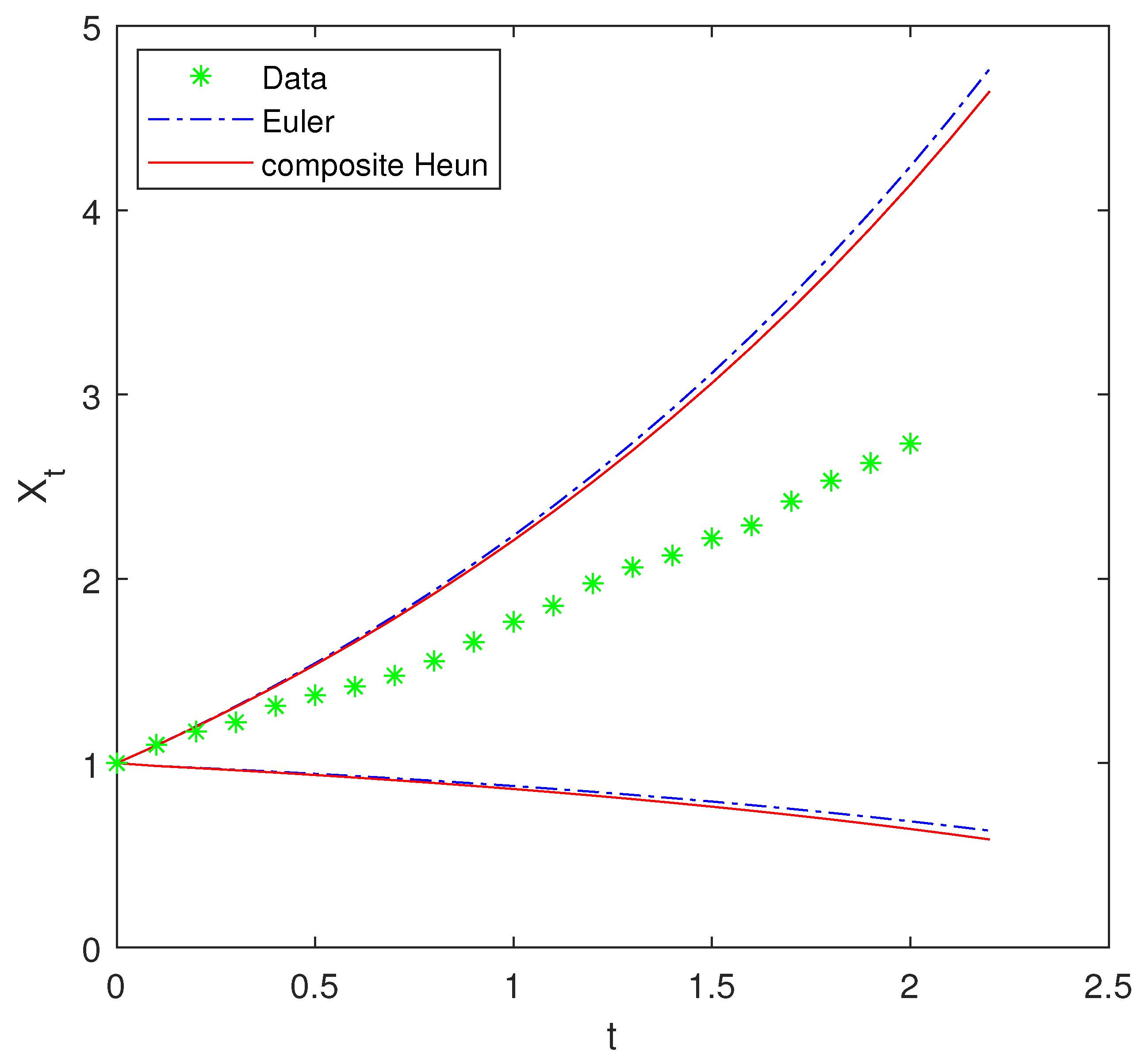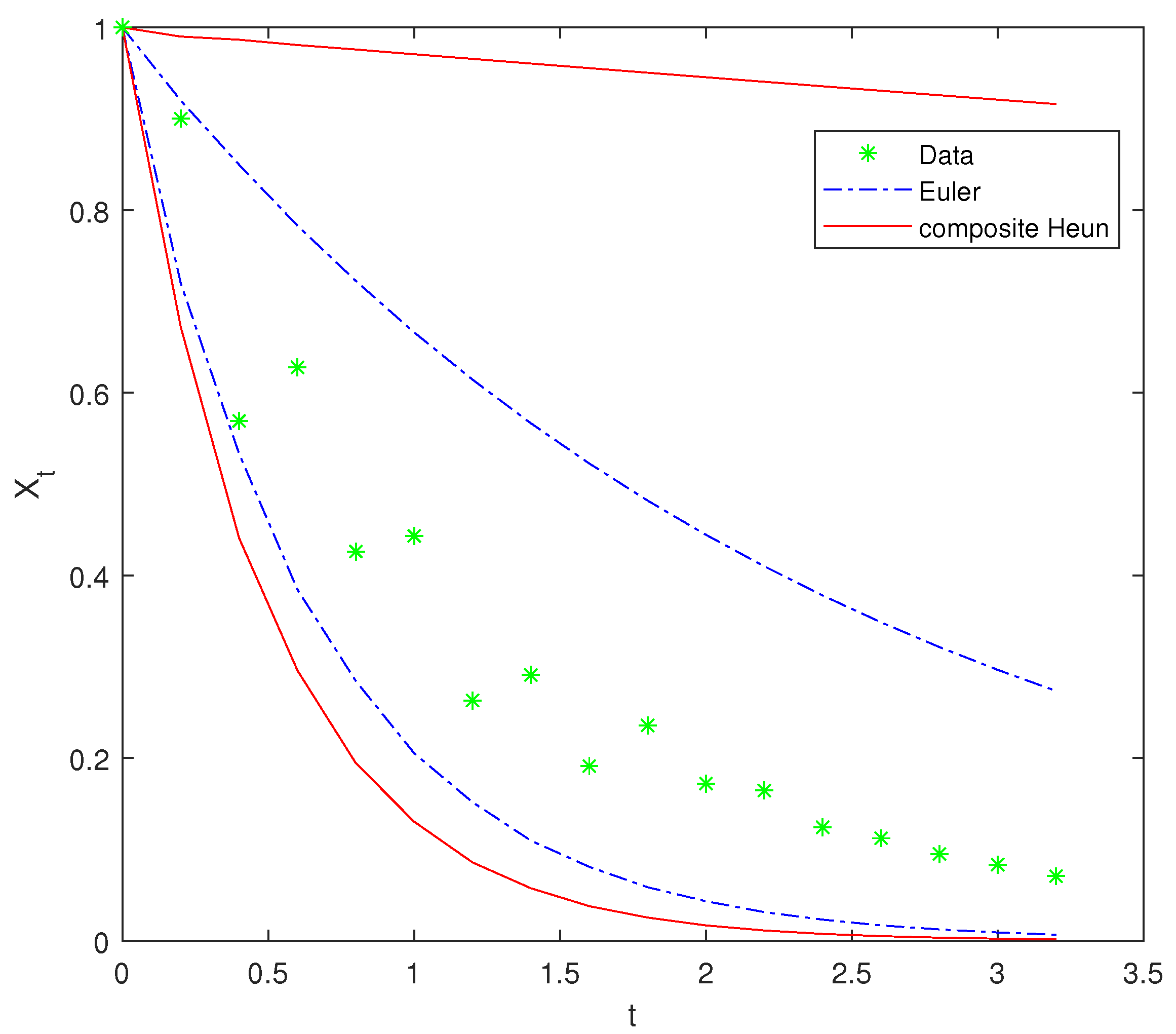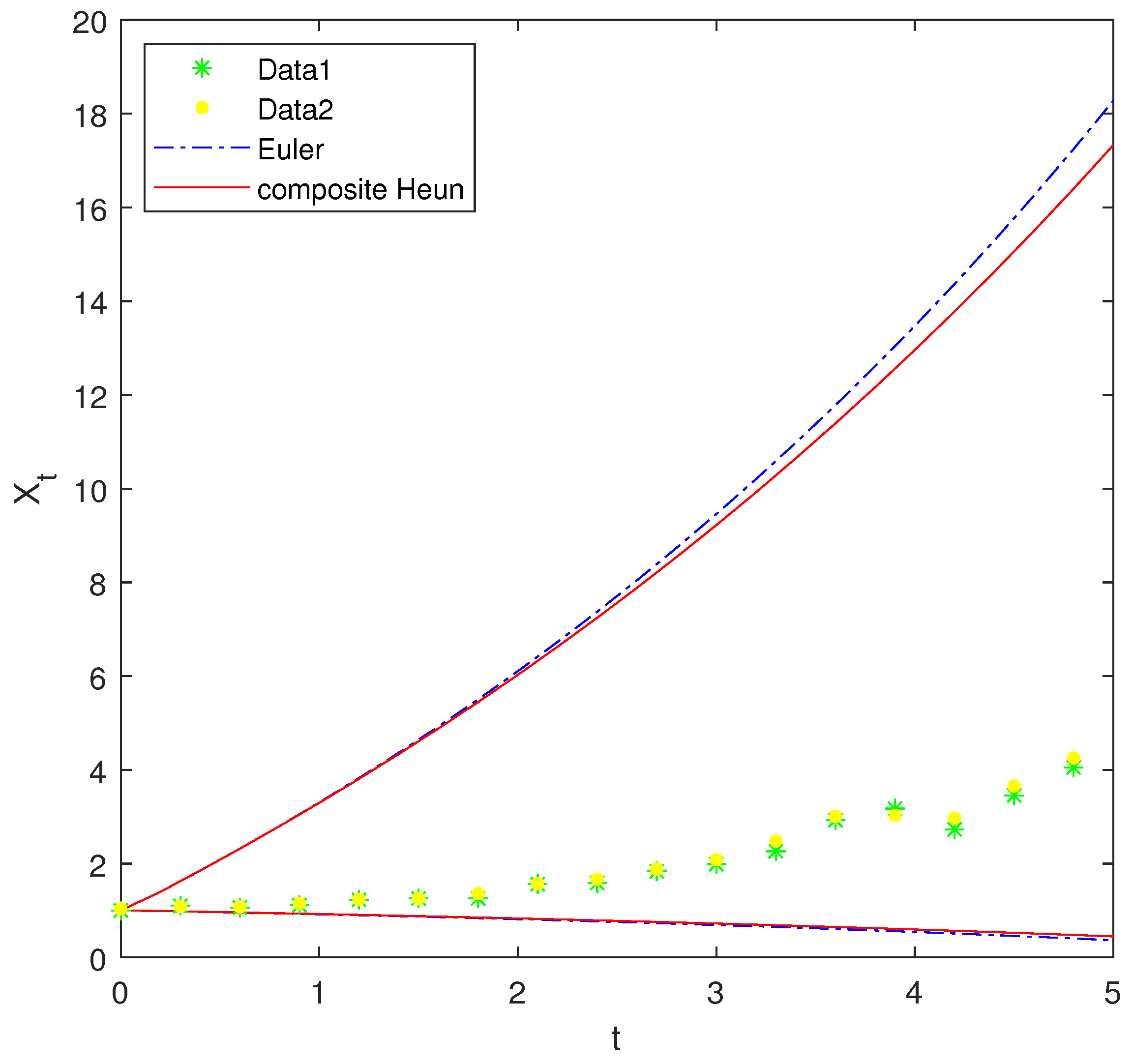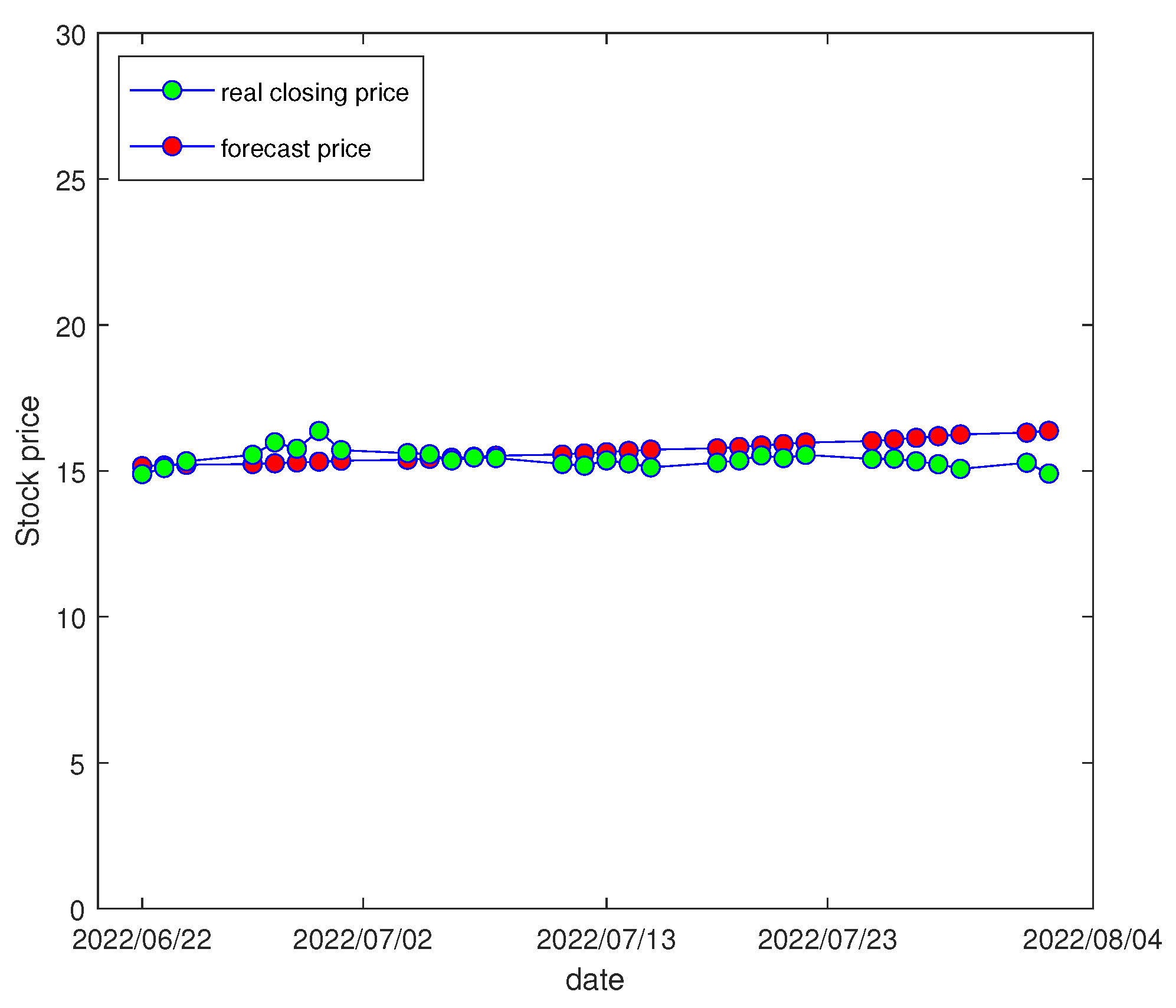Moment Estimation for Uncertain Delay Differential Equations via the Composite Heun Scheme
Abstract
1. Introduction
2. Parameter Estimation for Uncertain Delay Differential Equations with Integer Delay Time
3. Parameter Estimation for Uncertain Delay Differential Equations with Noninteger Delay Time
4. Numerical Examples
5. Uncertain Delay Stock Model
- Step 1. Suppose and determine a time t.
- Step 2. Set ←.
- Step 3. Compute from the following equationwith numerical method.
- Step 4. Repeat Step 2 and Step 3 99 times, and we can get the for every as shown in the following Table 8.
- Step 5 The expected value is
6. Conclusions
Author Contributions
Funding
Data Availability Statement
Conflicts of Interest
References
- Bahar, A.; Mao, X. Stochastic delay population dynamics. J. Int. Appl. Math. 2004, 11, 377–400. [Google Scholar]
- Villasana, M.; Radunskaya, A. A delay differential equation model for tumor growth. J. Math. Biol. 2003, 47, 270–294. [Google Scholar] [CrossRef]
- Roussel, M.R. The use of delay differential equations in chemical kinetics. J. Phys. Chem. 1996, 100, 8323–8330. [Google Scholar] [CrossRef]
- Liu, M.; Wang, K.; Hong, Q. Stability of a stochastic logistic model with distributed delay. Math. Comput. Model. 2013, 57, 1112–1121. [Google Scholar] [CrossRef]
- Shen, Y.; Meng, Q.; Shi, P. Maximum principle for mean-field jump–diffusion stochastic delay differential equations and its application to finance. Automatica 2014, 50, 1565–1579. [Google Scholar] [CrossRef]
- Tian, T.; Burrage, K.; Burrage, P.M.; Carletti, M. Stochastic delay differential equations for genetic regulatory networks. J. Comput. Appl. Math. 2007, 205, 696–707. [Google Scholar] [CrossRef]
- Ma, H.; Liu, B. Optimal control problem for risk-sensitive mean-field stochastic delay differential equation with partial information. Asian J. Control 2017, 19, 2097–2115. [Google Scholar] [CrossRef]
- Kahneman, B.D.; Tversky, A. Prospect theory: An analysis of decisions under risk. Econometrica 1979, 47, 263–291. [Google Scholar] [CrossRef]
- Liu, B. Uncertainty Theory, 2nd ed.; Springer: Berlin/Heidelberg, Germany, 2007. [Google Scholar]
- Liu, B. Some research problems in uncertainty theory. J. Uncertain Syst. 2009, 3, 3–10. [Google Scholar]
- Jadlovská, I.; Li, T. A note on the oscillation of third-order delay differential equation. Appl. Math. Lett. 2025, 167, 109555. [Google Scholar] [CrossRef]
- Batiha, B.; Alshammari, N.; Aldosari, F.; Masood, F.; Bazighifan, O. Nonlinear Neutral Delay Differential Equations: Novel Criteria for Oscillation and Asymptotic Behavior. Mathematics 2025, 13, 147. [Google Scholar] [CrossRef]
- Liu, B. Fuzzy process, hybrid process and uncertain process. J. Uncertain Syst. 2008, 2, 3–16. [Google Scholar]
- Barbacioru, C. Uncertainty functional differential equations for finance. Surv. Math. Appl. 2010, 5, 275–284. [Google Scholar]
- Ge, X.; Zhu, Y. Existence and uniqueness theorem for uncertain delay differential equations. J. Comput. Inf. Syst. 2012, 8, 8341–8347. [Google Scholar]
- Wang, X.; Ning, Y. Stability of uncertain delay differential equation. J. Intell. Fuzzy Syst. 2017, 32, 2655–2664. [Google Scholar] [CrossRef]
- Jia, L.; Sheng, Y. Stability in distribution for uncertain delay differential equation. Appl. Math. Comput. 2019, 343, 49–56. [Google Scholar] [CrossRef]
- Yao, K.; Liu, B. Parameter estimation in uncertain differential equations. Fuzzy Optim. Decis. Mak. 2020, 19, 1–12. [Google Scholar] [CrossRef]
- Liu, Z. Generalized moment estimation for uncertain differential equations. Appl. Math. Comput. 2021, 392, 125724. [Google Scholar] [CrossRef]
- Yao, L.; Zhang, G.; Sheng, Y. Generalized moment estimation of multi-dimensional uncertain differential equations. J. Intell. Fuzzy Syst. 2023, 44, 2427–2439. [Google Scholar] [CrossRef]
- Sheng, Y.; Yao, K.; Chen, X. Least squares estimation in uncertain differential equations. IEEE. Trans. Fuzzy Syst. 2019, 28, 2651–2655. [Google Scholar] [CrossRef]
- Liu, Z.; Jia, L. Moment estimations for parameters in uncertain delay differential equations. J. Intell. Fuzzy Syst. 2020, 39, 841–849. [Google Scholar] [CrossRef]
- Gao, Y.; Gao, J.; Yang, X. Parameter estimation in uncertain delay differential equations via the method of moments. Appl. Math. Comput. 2022, 431, 127311. [Google Scholar] [CrossRef]
- Li, A.; Xia, Y. Parameter estimation of uncertain differential equations with estimating functions. Soft Comput. 2024, 28, 77–86. [Google Scholar] [CrossRef]
- He, L.; Zhu, Y.; Gu, Y. Nonparametric estimation for uncertain differential equations. Fuzzy Optim. Decis. Mak. 2023, 22, 697–715. [Google Scholar] [CrossRef]
- He, L.; Zhu, Y. Nonparametric estimation for uncertain fractional differential equations. Chaos Solitons Fractals 2024, 178, 114342. [Google Scholar] [CrossRef]
- Zhou, S.; Tan, X.; Wang, X. Moment estimation based on the composite Heun scheme for parameters in uncertain differential equations. J. Intell. Fuzzy Syst. 2023, 45, 4239–4248. [Google Scholar] [CrossRef]
- Andersen, T.G.; Benzoni, L.; Lund, J. An empirical investigation of continuous-time equity return models. J. Financ. 2002, 57, 1239–1284. [Google Scholar] [CrossRef]
- Arriojas, M.; Hu, Y.; Mohammed, S.E.; Pap, G. A delayed Black and Scholes formula. Stoch. Anal. Appl. 2007, 25, 471–492. [Google Scholar] [CrossRef]
- Mao, X.; Sabanis, S. Delay geometric Brownian motion in financial option valuation. Stochastics Int. J. Probab. Stoch. Processes 2013, 85, 295–320. [Google Scholar] [CrossRef]
- Yao, K.; Chen, X. A numerical method for solving uncertain differential equations. J. Intell. Fuzzy Syst. 2013, 25, 825–832. [Google Scholar] [CrossRef]





| n | 0 | 1 | 2 | 3 | 4 | 5 | 6 |
|---|---|---|---|---|---|---|---|
| 0 | 0.1 | 0.2 | 0.3 | 0.4 | 0.5 | 0.6 | |
| 1 | 1.1000 | 1.1714 | 1.2216 | 1.3100 | 1.3682 | 1.4157 | |
| n | 7 | 8 | 9 | 10 | 11 | 12 | 13 |
| 0.7 | 0.8 | 0.9 | 1.0 | 1.1 | 1.2 | 1.3 | |
| 1.4752 | 1.5544 | 1.6574 | 1.7670 | 1.8543 | 1.9748 | 2.0633 | |
| n | 14 | 15 | 16 | 17 | 18 | 19 | 20 |
| 1.4 | 1.5 | 1.6 | 1.7 | 1.8 | 1.9 | 2.0 | |
| 2.1272 | 2.2207 | 2.2895 | 2.4210 | 2.5324 | 2.6284 | 2.7348 |
| Euler | 0.5175 | 0.2422 | 0.0175 | 0.0422 |
| Composite Heun | 0.5005 | 0.2419 | 0.0005 | 0.0419 |
| n | 0 | 1 | 2 | 3 | 4 | 5 | 6 | 7 | 8 | 9 | 10 | 11 | 12 | 13 | 14 | 15 | 16 |
|---|---|---|---|---|---|---|---|---|---|---|---|---|---|---|---|---|---|
| 0 | 0.2 | 0.4 | 0.6 | 0.8 | 1.0 | 1.2 | 1.4 | 1.6 | 1.8 | 2.0 | 2.2 | 2.4 | 2.6 | 2.8 | 3.0 | 3.2 | |
| 1 | 0.9000 | 0.5691 | 0.6277 | 0.4261 | 0.4432 | 0.2630 | 0.2909 | 0.1911 | 0.2357 | 0.1719 | 0.1644 | 0.1241 | 0.1122 | 0.0949 | 0.0832 | 0.0706 |
| Euler | 0.5973 | 0.4569 | 0.5138 | 0.3661 |
| Composite Heun | 0.1836 | 0.0924 | 0.2120 | 0.3326 |
| n | 0 | 1 | 2 | 3 | 4 | 5 | 6 | 7 | 8 | 9 | 10 | 11 | 12 | 13 | 14 | 15 | 16 |
|---|---|---|---|---|---|---|---|---|---|---|---|---|---|---|---|---|---|
| 0 | 0.3 | 0.6 | 0.9 | 1.2 | 1.5 | 1.8 | 2.1 | 2.4 | 2.7 | 3.0 | 3.3 | 3.6 | 3.9 | 4.2 | 4.5 | 4.8 | |
| 1 | 1.1000 | 1.0647 | 1.1133 | 1.2314 | 1.2574 | 1.2577 | 1.5619 | 1.5889 | 1.8360 | 1.9894 | 2.2635 | 2.9276 | 3.1762 | 2.7324 | 3.4564 | 4.0529 | |
| 1.0333 | 1.0882 | 1.0809 | 1.1527 | 1.2401 | 1.2575 | 1.3591 | 1.5702 | 1.6699 | 1.8871 | 2.0808 | 2.4849 | 3.0105 | 3.0283 | 2.9737 | 3.6552 |
| Euler | 0.0621 | 0.0267 | 0.0600 |
| Composite Heun | 0.0406 | 0.0096 | 0.0599 |
| 14.48 | 14.65 | 14.76 | 14.67 | 14.62 | 14.80 | 14.86 | 14.70 | 14.71 |
| 14.80 | 14.95 | 14.92 | 14.52 | 14.78 | 14.99 | 15.00 | 15.25 | 15.41 |
| 15.53 | 15.39 | 15.34 | 15.22 | 15.22 | 15.12 | 15.21 | 15.04 | 15.10 |
| 15.15 | 15.05 | 14.99 | 15.18 | 15.14 | 14.89 | 15.10 | 15.33 | 15.55 |
| 15.98 | 15.76 | 16.37 | 15.71 | 15.61 | 15.57 | 15.36 | 15.46 | 15.44 |
| 15.24 | 15.18 | 15.36 | 15.26 | 15.12 | 15.28 | 15.36 | 15.53 | 15.44 |
| 15.55 | 15.41 | 15.42 | 15.33 | 15.23 | 15.07 | 15.28 | 14.91 |
| 0.01 | 0.02 | … | 0.99 | |
|---|---|---|---|---|
| … |
| Date | Actual Value | Predicted Value |
|---|---|---|
| 22 June 2022 | 14.89 | 15.1627 |
| 23 June 2022 | 15.10 | 15.1855 |
| 24 June 2022 | 15.33 | 15.2095 |
| 27 June 2022 | 15.55 | 15.2348 |
| 28 June 2022 | 15.98 | 15.2614 |
| 29 June 2022 | 15.76 | 15.2894 |
| 30 June 2022 | 16.37 | 15.3186 |
| 01 July 2022 | 15.71 | 15.3492 |
| 04 July 2022 | 15.61 | 15.3811 |
| 05 July 2022 | 15.57 | 15.4143 |
| 06 July 2022 | 15.36 | 15.4488 |
| 07 July 2022 | 15.46 | 15.4847 |
| 08 July 2022 | 15.44 | 15.5220 |
| 11 July 2022 | 15.24 | 15.5606 |
| 12 July 2022 | 15.18 | 15.6006 |
| 13 July 2022 | 15.36 | 15.6419 |
| 14 July 2022 | 15.26 | 15.6847 |
| 15 July 2022 | 15.12 | 15.7288 |
| 18 July 2022 | 15.28 | 15.7744 |
| 19 July 2022 | 15.36 | 15.8214 |
| 20 July 2022 | 15.53 | 15.8698 |
| 21 July 2022 | 15.44 | 15.9196 |
| 22 July 2022 | 15.55 | 15.9710 |
| 25 July 2022 | 15.41 | 16.0238 |
| 26 July 2022 | 15.42 | 16.0780 |
| 27 July 2022 | 15.33 | 16.1338 |
| 28 July 2022 | 15.23 | 16.1910 |
| 29 July 2022 | 15.07 | 16.2498 |
| 1 August 2022 | 15.28 | 16.3102 |
| 2 August 2022 | 14.91 | 16.3720 |
Disclaimer/Publisher’s Note: The statements, opinions and data contained in all publications are solely those of the individual author(s) and contributor(s) and not of MDPI and/or the editor(s). MDPI and/or the editor(s) disclaim responsibility for any injury to people or property resulting from any ideas, methods, instructions or products referred to in the content. |
© 2025 by the authors. Licensee MDPI, Basel, Switzerland. This article is an open access article distributed under the terms and conditions of the Creative Commons Attribution (CC BY) license (https://creativecommons.org/licenses/by/4.0/).
Share and Cite
Zhou, S.; Zhang, H.; Liu, C.; Wang, X. Moment Estimation for Uncertain Delay Differential Equations via the Composite Heun Scheme. Mathematics 2025, 13, 3495. https://doi.org/10.3390/math13213495
Zhou S, Zhang H, Liu C, Wang X. Moment Estimation for Uncertain Delay Differential Equations via the Composite Heun Scheme. Mathematics. 2025; 13(21):3495. https://doi.org/10.3390/math13213495
Chicago/Turabian StyleZhou, Shaoling, Huimin Zhang, Chiteng Liu, and Xiaosheng Wang. 2025. "Moment Estimation for Uncertain Delay Differential Equations via the Composite Heun Scheme" Mathematics 13, no. 21: 3495. https://doi.org/10.3390/math13213495
APA StyleZhou, S., Zhang, H., Liu, C., & Wang, X. (2025). Moment Estimation for Uncertain Delay Differential Equations via the Composite Heun Scheme. Mathematics, 13(21), 3495. https://doi.org/10.3390/math13213495






